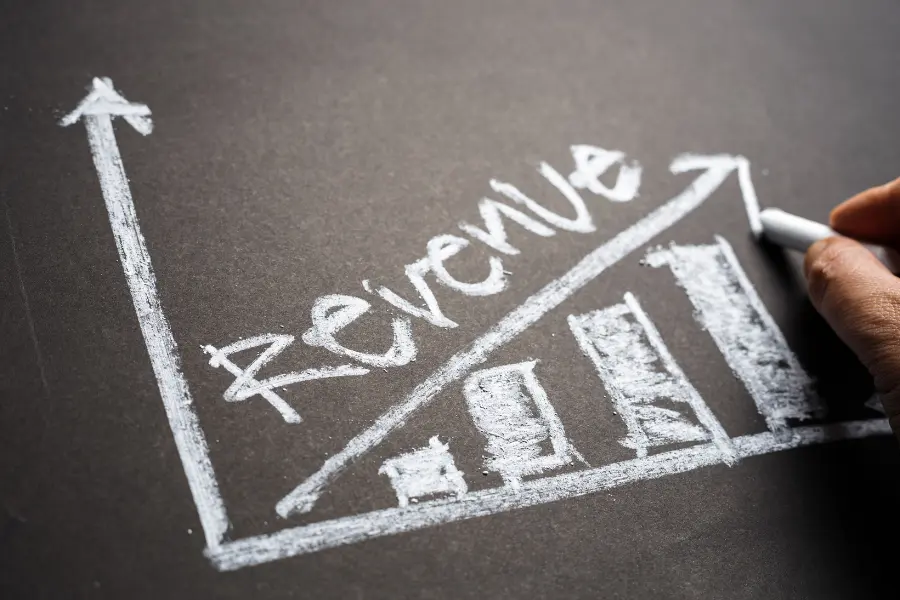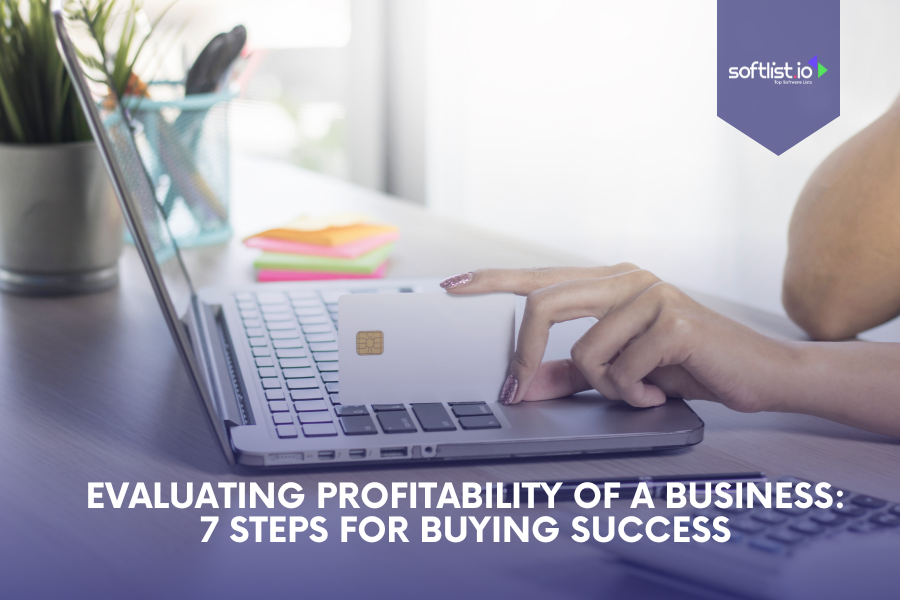Buying a business is a significant decision, and understanding its potential profitability is crucial. Whether you’re a seasoned entrepreneur, looking at a business for sale, or a newcomer eager to enter a new venture like a franchise, evaluating how a company stands in terms of profit is something you can’t overlook.
This isn’t about endless spreadsheets or indecipherable financial jargon. It’s about clear, actionable insights that reveal whether a small or large business survives and thrives. From negotiating with a broker to working with a seller on financing, you must be confident the business is worth the investment.
In this guide, you’ll learn a streamlined approach using seven straightforward steps to assess a business’s profitability. We’ll explore critical indicators and metrics that can help you determine the proper financial health of any enterprise.
Key Takeaways
- Focus on Profitability Metrics and Revenue Stability: Start by understanding key profitability metrics like operating profit margin, which shows how efficiently a business turns revenue into profit. Then, evaluate the stability and sustainability of revenue streams, identifying growth potential and customer retention to forecast long-term profitability.
- Conduct a Detailed Cost and Break-even Analysis: A deep analysis of both fixed and variable costs is essential for understanding a business’s financial health. Perform a break-even analysis to determine when the business’s revenue will cover all costs, providing insight into its potential for future profitability.
- Assess Market Position and Forecast Future Growth: Evaluate the business’s competitive advantage and market trends to gauge its position in the industry. Use financial modeling and profit projections to anticipate future growth and ensure your investment will thrive over time.
Step 1: Define Profitability Metrics

Source: Canva
When you’re considering buying a business, one of the first things you need to do is understand its profitability. Profitability metrics are like the report card of a business. They tell you how well the business is doing and help you make intelligent decisions.
Whether looking at a small business, a business or franchise, or even considering selling a business, knowing how to evaluate financials is crucial. Let’s break these metrics down into simpler terms.
Importance of Operating Profit Margin
The operating profit margin acts as a financial compass, guiding potential buyers like yourself in terms of operating efficiency. Whether you’re starting a business or buying an existing one, this metric can help you assess a company’s financial health and its potential for success.
This margin (calculated as operating income divided by total revenue, then multiplied by 100) reflects what percentage of revenue turns into profit before paying taxes and interest. It’s crucial because it focuses solely on core business operations, excluding one-time payments or external investments. For business buyers, it gives insight into how well the business runs its daily operations—whether you’re looking at a well-established business or a new acquisition in the world’s largest marketplace.
For instance, if our candy shop’s operating income is $3,500, with total revenues of $10,000, the operating profit margin would be 35%. This number highlights the shop’s ability to maintain profitability from its business operations alone, which is critical for those with years of experience in buy-and-sell transactions or for someone looking to secure ownership of the right business.
Understanding the operating profit margin can help you make informed decisions in a competitive marketplace. It’s an essential step toward evaluating whether the business you’re considering is a successful business that aligns with your financial goals.
By focusing on this metric, you’ll ensure that you’re investing in a business with solid operational efficiency—helping you secure the right company, whether buying an existing business or aiming for a new acquisition. Want to make intelligent decisions in your business journey? Learn how to evaluate profitability with these seven steps for success!
Step 2: Analyze Revenue Streams

Source: Canva
Understanding how a business generates its income is essential for evaluating its profitability. Whether you’re an investor, advisor, or business buyer, taking the time to thoroughly analyze revenue streams helps you identify where the money comes from and how stable and sustainable these sources are over time. This insight is critical for buyers and sellers alike, especially in businesses’ buy and sell process.
Let’s break down this step into two critical tasks:
Identifying Revenue Sources
To effectively identify revenue sources, you need to categorize where your income originates. Whether you’re considering buying or selling a business, understanding revenue streams is essential to evaluating profitability. This can be through goods, services, or other financial instruments. Identifying these streams helps you assess the business’s potential for a high profit margin and long-term success.
Here are some common methods to identify and categorize revenue sources:
- Direct Sales: Evaluate the main products or services your business offers. For most businesses, direct sales form the backbone of their revenue. For instance, in a current job selling electronics, direct sales would include the income from each product sold, contributing to a steady cash flow. Whether you’re working with a management company or an independent small business, direct sales are typically the most significant income stream.
- Subscription Fees: Regular income through subscription models offers a reliable and predictable revenue stream. Businesses that provide services through monthly or annual subscriptions often enjoy steady cash flow. Platforms like Netflix or Spotify are great examples of high-profit businesses that thrive using this model. For small businesses with a great location, adding a subscription service can increase monthly revenue and stabilize cash flow.
- Usage Fees: Some businesses charge customers based on how frequently a service is used. This is similar to how mobile providers charge for data overages or pay-as-you-go services. Usage fees are widespread in sectors where customers pay based on consumption, such as utilities or telecommunications.
- Licensing: Licensing allows you to open additional revenue channels by permitting other businesses to use your products, patents, or technology. This is especially useful for businesses that may not have high direct sales but own valuable intellectual property. In 2023, businesses that license their technology or products can significantly boost their revenue streams without needing to sell additional physical goods.
- Advertising: If your business has a solid digital presence, advertising can become a lucrative source of income. Websites, apps, or social media platforms can sell advertising space to other businesses, creating an additional revenue stream. For companies ready to buy or invest in a robust online presence, this can be a high-profit margin strategy that boosts income without increasing operational costs.
Assessing Revenue Stability
Once you’ve identified a business’s income sources, assessing their stability is crucial. This step helps potential buyers determine whether those revenue streams are consistent and potentially growing over time, which is essential for making an informed decision in the sales process, especially when considering high-profit margin businesses. Here’s how you can assess revenue stability effectively:
- Historical Data Analysis: Review past financial statements to track revenue trends over several years. This historical data analysis will give you insight into the patterns of each revenue stream and help forecast future revenues. When considering selling businesses, this hands-on approach can also highlight consistent growth areas, attracting more buyers.
- Growth Rates: Calculate the year-on-year growth rate of each revenue stream. This metric is vital to understanding whether the business is expanding, stagnating, or declining. For companies with high-profit margins, steady growth rates are crucial indicators of long-term stability. Knowing how much a business earns per month from different revenue streams also helps plan future mergers or acquisitions.
- Market Demand: Investigate market trends to predict if demand for your products or services will remain steady, increase, or decline. This can involve analyzing the overall industry, competitor performance, and shifts in consumer behavior. If market demand is projected to grow, this means the business could have strong future revenue potential. Listings in a directory of businesses for sale with strong market positions will be far more attractive to buyers looking for reliable returns.
- Customer Retention Metrics: High customer retention rates often hint at stable and reliable revenue streams. The lifetime value of customers becomes an essential metric here—if your customers return regularly, your revenue is more likely to remain stable. Hands-on business owners who focus on retaining their client base will often see the benefits reflected in steady growth and profit. This is particularly appealing when considering equity in a merger or acquisition
Analyzing revenue streams isn’t just about knowing where your money comes from; it’s about understanding the potential for each source to contribute consistently over time. By mastering this, you set the foundation for evaluating the complete profitability picture when you decide to buy a business.
Step 3: Conduct Cost Analysis

Source: Canva
Evaluating the profitability of a business isn’t complete without a thorough cost analysis. This step is crucial to understanding where your money goes and what it takes to maintain operations.
By identifying and classifying costs, you can better gauge the financial health of a business before deciding to buy it. Let’s break down these costs into two main categories: fixed and variable.
Identifying Fixed Costs
Fixed costs remain constant regardless of the business activity level. Examples include rent, salaries, equipment leases, and insurance. These expenses don’t fluctuate with sales volume and must be paid regardless of how much revenue the business generates.
Understanding fixed costs is vital to determining a company’s break-even point. Fixed costs can significantly impact a business’s profitability by creating a threshold that sales must surpass to generate profit. Imagine these costs like a toll bridge you must cross to derive profit from each unit sold. The cost of maintaining this bridge does not change with the number of vehicles crossing it each day.
Moreover, high fixed costs mean that the business needs to maintain a certain sales volume to remain viable. Companies with high fixed costs may struggle during downturns unless they have healthy reserves or adaptable operations. Therefore, knowing these costs helps you understand the risk level involved with the business.
Classifying Variable Costs
Unlike fixed costs, variable costs change based on the production level or sales volume. Common examples include direct materials, packaging, and sales commissions. As sales increase, variable costs also rise, and vice versa.
Variable costs are like a chameleon adjusting to its environment. They directly influence gross profits as more sales typically mean more costs. However, businesses can manage variable costs effectively to drive profit margins higher. Strategies to manage these costs include:
- Negotiating with suppliers: Obtain better rates on materials.
- Streamlining operations: Optimize productions to reduce wastage.
- Automating processes: Implement technologies to decrease labor costs.
By controlling variable costs, a business can become more competitive, adapting its cost structure to align better with sales trends. Effectively managing variable costs not only improves profitability but also provides a buffer during financial fluctuations, making the business a more attractive buy opportunity.
Conducting a comprehensive cost analysis forms the backbone of any strategy aimed at assessing a business for purchase. Understanding these cost elements ensures you are well-prepared to make an informed decision.
Step 4: Perform Break-even Analysis

Source: Canva
Understanding where your business stands in terms of profitability is crucial. One way to gauge this is through a break-even analysis.
This tool allows you to see when your revenue will cover all of your costs. Why is this important? Because it tells you the point at which you start making money—essential for buying a business or planning for future investments. Let’s break it down.
Understanding Break-even Implications
Knowing your break-even point is more than just a number—it’s a powerful insight into your business. It informs you about pricing strategies and cost management, serving as a guide for critical decision-making. Imagine buying a unique company in the e-commerce or SaaS sector, and you want to determine if a new product line or service offering is worthwhile. A break-even analysis quickly tells you how viable that new venture is.
When you perform due diligence before buying a business, working closely with an accountant, understanding the break-even point helps you evaluate financial stability and profitability. It also permits you to access deeper insights into how various costs—both fixed and variable—impact the overall health of the business. This analysis becomes even more important when managing contracts and creative solutions, such as introducing new pricing models or expanding operations.
Moreover, understanding this analysis can help when setting goals and targets. If costs rise or revenue dips, you’ll know instantly how these changes affect your bottom line. For example, in a SaaS business, where monthly revenue may fluctuate, knowing your break-even point helps ensure you’re always on top of profitability.
Ultimately, the break-even analysis is a snapshot of the present and a crystal ball for the future, helping you steer your business wisely. Whether buying a business, scaling up operations in an e-commerce platform, or maintaining the status quo, knowing your break-even point is a foundational step toward success.
Step 5: Evaluate Financial Ratios

Source: Canva
Understanding financial ratios provides a clear view of the company’s financial health, giving insights into its performance and profitability.
For those considering buying a business, mastering these ratios is crucial.
Return on Investment (ROI)
Return on Investment (ROI) calculates how much profit you gain from an investment relative to its cost. It’s an important metric for evaluating profitability because it helps you understand how effectively a business is utilizing its investments to generate returns.
To calculate ROI, use this simple formula:
ROI (%) = [(Net Profit) / (Cost of Investment)] * 100
For example, if your cost was $5,000 and your profit was $1,000, your ROI would be:
ROI = (1000 / 5000) * 100 = 20%
A higher ROI indicates a better investment return, meaning you’re getting more bang for your buck. For more details on ROI and how to apply it, you can read this ROI guide from Investopedia.
Return on Assets (ROA)
The Return on Assets (ROA) measures how well a company can convert its assets into profits. It’s a crucial ratio because it offers insights into the efficiency of asset utilization. Essentially, it tells you how good a business is at spinning its assets into profits.
The formula to calculate ROA is:
ROA (%) = (Net Income / Total Assets) * 100
If a company maintains a net income of $200,000 and total assets of $2,000,000, the ROA becomes:
ROA = (200,000 / 2,000,000) * 100 = 10%
A higher ROA signifies that the company is using its assets efficiently to generate earnings.
By analyzing these financial ratios, prospective business owners can make informed decisions and ensure they’re investing wisely. Taking these steps can mean the difference between buying a thriving enterprise and a sinking ship.
Step 6: Assess Profitable Market Position

Source: Canva
Understanding a business’s market position is like looking at a map before a big journey. It’s knowing where you stand today to figure out where you need to go tomorrow. This step is crucial for those looking to buy a business because it determines how the business stacks up against its competitors and evaluates if there’s room for growth.
Let’s break it down into two main parts: competitive advantage and market trends.
Understanding Competitive Advantage
Competitive advantage is the secret ingredient that allows a business to stand out. Think of it as a superhero power that can boost profitability. What makes a company unique in how it attracts and keeps its customers? This could be anything from having a brand where customers see it as trustworthy or offering a product that’s far superior compared to others.
Companies with a strong competitive advantage, like those featured on Investopedia, tend to have a loyal customer base and higher profit margins. Understanding how a business you’re interested in buying uses its resources to maintain an edge is vital.
Here’s how it can enhance profitability:
- Higher Pricing Power: Companies with a competitive edge can charge more because they offer something special.
- Better Customer Loyalty: Unique advantages keep customers coming back, ensuring a consistent revenue flow.
- Cost Efficiency: Businesses may produce their goods at a lower cost than competitors, increasing their profit margins.
Analyzing Marketplace Trends
Let’s face it—being stuck in the past can halt growth. That’s why understanding and analyzing market trends is like having a crystal ball for business. Trends inform potential business owners where the market is headed and which products will be in demand.
This foresight is invaluable for planning long-term strategies and ensuring a business can adapt to changes that could affect profitability.
Here’s why keeping track of trends is necessary:
- Adapting to Consumer Desires: Customers’ needs change. Understanding trends helps meet these evolutions efficiently.
- Recognizing Emerging Markets: Spot potential new opportunities before your competitors do.
- Investment Guidance: Helps decide which areas to allocate resources for maximum growth.
Overall, assessing market position involves looking deeply into what gives a business an edge and keeping an ear to the ground about market shifts. This ensures that your potential investment isn’t just profitable today, but also in the years to come.
Step 7: Forecast Future Profitability

Source: Canva
Forecasting future profitability is a crucial part of evaluating a business, especially if you’re in the market to buy a business. Predicting how a business will perform allows you to make informed decisions by analyzing potential future earnings.
This process involves investigating profit projections and leveraging financial modeling tools. Here’s how you can approach this important task.
Creating Profit Projections
Creating accurate profit projections is key to understanding the future success of a business. It’s not just a matter of wishful thinking; it requires analyzing solid data and making logical assumptions.
- Analyze Historical Data: Start by examining past financial statements to identify trends in sales, expenses, and profits. Use these trends as a baseline for future projections.
- Consider External Factors: Look at industry trends and economic forecasts that might impact the business’s market. For instance, changes in consumer preferences or new regulations could affect profitability.
- Create Financial Statements: Develop a comprehensive set of financial statements, including income statements, cash flow statements, and balance sheets, to support your projections
Building these projections helps you visualize potential outcomes and prepares you to tackle unexpected challenges.
Utilizing Financial Modeling
Financial modeling acts as a crystal ball for your business’s future. It blends historical data with assumptions about future performance to simulate various scenarios.
- Build a Model: Begin by creating a financial model that integrates the data gathered. This framework should include assumptions about revenue growth, cost trends, and capital investments.
- Simulate Scenarios: Use the model to simulate different business conditions. For instance, what happens if sales increase by 10%? Or if operating costs rise? These scenarios help you prepare for various outcomes.
- Analyze Results: Interpret the model’s results to identify potential risks and areas for growth. Financial modeling tools and services, such as those outlined by Forecastr, can offer detailed insights into crafting your model.
By employing financial modeling, you gain better insight into what the future holds, allowing you to strategize effectively and make more confidently informed business decisions.
By focusing on profitable forecasting, you ensure that your potential investment is grounded in reality and optimism, making each step forward a calculated move. This process not only sets you up for success but also helps protect your financial future when looking to buy a business.
Best Buy and Sell Online Businesses
|
Primary Rating:
3.5
|
Primary Rating:
3.5
|
Primary Rating:
3.5
|
Conclusion
Accurately evaluating the profitability of a business is more than just a financial exercise; it’s crucial whether you’re looking to buy a business or refine current operations. By following these seven structured steps, you can gain a comprehensive understanding of where the business stands financially and strategically.
Taking action is your next move. Implement the insights gathered from this evaluation to decide if this business venture aligns with your goals.
Profitability influences every decision. Don’t shy away from communicating your findings and engaging with other stakeholders.
Are you ready to make your next business investment count? Begin your evaluation today and seize the opportunities that informed decisions bring.
Want to stay updated with the latest tools and insights? Subscribe to our website for exclusive ‘Deals and Promotions’ and ‘Top Product Reviews’ straight to your inbox.
Also, check out our “Best Places to Buy Websites” blog article to discover the best platforms for buying online business!
FAQs about Evaluating Business Profitability
Evaluating the profitability of a business can seem challenging, but with the right approach and insight, it’s a manageable process. Here, we’ll cover common questions asked about key profitability metrics and analysis.
Understanding these details is crucial, whether you’re a business owner or considering buying a business.
What Is the Most Important Profitability Metric?
When determining profitability, one crucial metric stands out — the net profit margin. This ratio measures what percentage of revenue remains as profit after deducting all expenses. A higher net profit margin signifies better financial health.
Alongside this, the return on assets (ROA) is also key, indicating how effectively a business uses its assets to generate profit.
How Often Should Profitability Be Evaluated?
Regular evaluation is vital for staying abreast of a business’s financial health. Ideally, profitability should be reviewed quarterly. This frequency allows for timely adjustments to strategy if unusual trends or issues emerge.
For smaller enterprises, monthly assessments could be more beneficial, providing faster insights into their financial dynamics.
Is Profitability the Only Factor to Consider?
Profitability is just one piece of the puzzle. While it indicates financial success, other factors such as market conditions, cash flow, and operational efficiency also play critical roles. These elements help in measuring long-term sustainability.
What Are Common Pitfalls in Profitability Analysis?
Several mistakes can distort profitability evaluation. These include neglecting the indirect costs, overlooking seasonal trends, and failing to update financial records regularly. Another frequent error is misunderstanding the nuances of each profitability metric. Ensuring accuracy in financial data and clear objectives helps avoid these issues.
How Do I Improve Profitability?
Improving profitability hinges on several strategies:
- Cost Reduction: Examine expenses and identify areas for cuts without sacrificing quality. Streamlining operations helps too.
- Increase Revenue: Consider expanding product lines or entering untapped markets to boost sales.
- Focus on High-Margin Products: Prioritizing products or services with higher profit margins can significantly enhance overall profitability.
Strategies vary depending on the business model, but focusing on these areas can yield significant improvements.
By understanding these FAQs, business owners can effectively handle profitability evaluation, making informed decisions to enhance their business value. Whether you’re running a business or looking to buy a business, mastering these concepts is essential for sustainable success.









